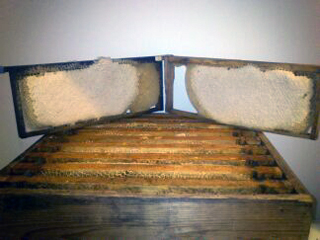 I knew we’d be taken by surprise when winter finally came – and then went again! The poor bees are quite confused! Winter is supposed to be a cold period during which, since there is no nectar in the fields for them, they stay at home and cluster tightly together to keep warm and to preserve their queen until the Spring. What we have had over the past month (apart from the rain) is warm weather, then cold, then warm again.
I knew we’d be taken by surprise when winter finally came – and then went again! The poor bees are quite confused! Winter is supposed to be a cold period during which, since there is no nectar in the fields for them, they stay at home and cluster tightly together to keep warm and to preserve their queen until the Spring. What we have had over the past month (apart from the rain) is warm weather, then cold, then warm again.
There is still some ivy that is yielding nectar on the milder days – and the bees are out there looking for it. There has been little clustering taking place, other than perhaps at night when the temperatures plummet, so the bees are gradually using up their winter stores to survive in the warm weather, the ivy nectar that they are bringing in being used for their brood, because the queen is still laying in quite sizeable brood nests. This is not what Nature intended and does not augur well for the survival of colonies through the winter if it carries on like this. We need some really cold weather, not just for the bees but to kill off all those bugs that thrive in warm temperatures, otherwise we will all pay the price later on.
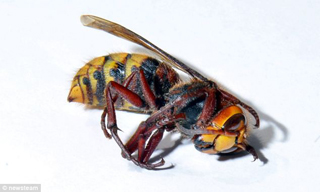 We currently have a threat of exotic pests crossing the Channel to take up residence in the UK because of the warmer climate we are experiencing as a planet. The two main ones are Small Hive Beetle and the Asian Hornet. The former is a potential threat to European and UK beekeeping and whilst indigenous to Africa, where it is considered a minor scavenger pest of honey bee colonies causing comparatively little harm, outside its native range, within colonies that lack African bees’ defenses, adult beetles enter hives unchecked causing devastating infestations.
We currently have a threat of exotic pests crossing the Channel to take up residence in the UK because of the warmer climate we are experiencing as a planet. The two main ones are Small Hive Beetle and the Asian Hornet. The former is a potential threat to European and UK beekeeping and whilst indigenous to Africa, where it is considered a minor scavenger pest of honey bee colonies causing comparatively little harm, outside its native range, within colonies that lack African bees’ defenses, adult beetles enter hives unchecked causing devastating infestations.
Until the late 1990s, the Small Hive Beetle was thought to be restricted to Africa where it thrives in the hot climate, but in 1998 it was detected in Florida and it is now very widespread throughout the United States including Hawaii, where it was first found in 2010. Currently, the Small Hive Beetle has spread to the USA, Canada, Mexico, Jamaica, Australia and most recently Italy, where it has proved it can be a very serious pest of the European honey bee.
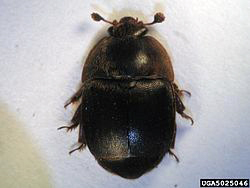 The beetle can multiply to huge numbers within infested colonies, laying thousands of eggs which hatch into larvae – which cause the main problems. The larvae eat brood, honey and pollen, destroy combs and cause fermentation and spoiling of the honey. If beetle infestations are uncontrolled they ultimately destroy the colony.
The beetle can multiply to huge numbers within infested colonies, laying thousands of eggs which hatch into larvae – which cause the main problems. The larvae eat brood, honey and pollen, destroy combs and cause fermentation and spoiling of the honey. If beetle infestations are uncontrolled they ultimately destroy the colony.
Economic impact on the beekeeping industry in the USA has been severe, since within two years of its discovery, at least 20,000 colonies have been destroyed by the beetle, costing many millions of dollars. It has been found in Manitoba, Canada where it arrived with beeswax imported from the USA and has also been reported in Quebec. In October 2002, it was found in New South Wales and Queensland, Australia.
 The economic consequences to the beekeeping industry in Australia have been serious, jeopardising bee exports, pollination services and honey production. Since 2002 the beetle has spread widely and is now considered endemic in New South Wales, Queensland and Victoria. It has also been found in North East of Western Australia close to Northern Territory. It is also present in Mexico and in Jamaica. This clearly shows the ability of the beetle to “hitch a ride” right across the world.
The economic consequences to the beekeeping industry in Australia have been serious, jeopardising bee exports, pollination services and honey production. Since 2002 the beetle has spread widely and is now considered endemic in New South Wales, Queensland and Victoria. It has also been found in North East of Western Australia close to Northern Territory. It is also present in Mexico and in Jamaica. This clearly shows the ability of the beetle to “hitch a ride” right across the world.
It is not known how the beetle reached either the USA or Australia, although in the USA shipping into the East Coast ports is considered the most likely route. By the time the beetle was detected in either country it was already well established, leaving little or no chance of eradication. The remaining options are to attempt to control it and slow down its spread. The potential implications for European apiculture are enormous, as we must now assume that the Small Hive Beetle, having spread to Europe, is likely to come to the UK and prove as harmful here as in Australia and the USA.
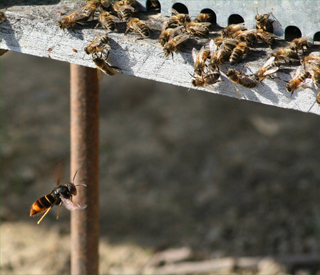 The second pest that perhaps we are likely to see first, though, is the Asian Hornet. This is an invasive non-native species from Asia. It has recently arrived in France where it is spreading rapidly. As a highly effective predator of insects, including honey bees and other beneficial species, it can cause significant losses to bee colonies, other native species and potentially ecosystems.
The second pest that perhaps we are likely to see first, though, is the Asian Hornet. This is an invasive non-native species from Asia. It has recently arrived in France where it is spreading rapidly. As a highly effective predator of insects, including honey bees and other beneficial species, it can cause significant losses to bee colonies, other native species and potentially ecosystems.
Although it is not yet present in the UK, it is considered likely to arrive soon. The places it is most likely to be found are in southern parts of England (it may be able to cross the channel from France) or goods among which it could be accidentally imported (such as soil with imported pot plants, cut flowers, fruit and timber). It is active during the main beekeeping season, viz between April and November (peak August/September).
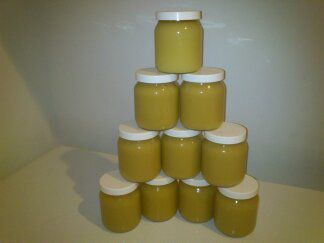 Asian Hornet queens are up to 30 mm (1.25inches) in length, workers up to 25 mm (1inch), slightly smaller than the native European hornet. They have an entirely dark brown or black velvety body, bordered with a fine yellow band. There is a single band on the abdomen which is almost entirely yellow/orange, and whilst it has brown legs with yellow ends its head is black with an orange/yellow face. Our native European Hornet, on the other hand, is like a large, yellow wasp.
Asian Hornet queens are up to 30 mm (1.25inches) in length, workers up to 25 mm (1inch), slightly smaller than the native European hornet. They have an entirely dark brown or black velvety body, bordered with a fine yellow band. There is a single band on the abdomen which is almost entirely yellow/orange, and whilst it has brown legs with yellow ends its head is black with an orange/yellow face. Our native European Hornet, on the other hand, is like a large, yellow wasp.
Groups of Asian hornets hover in front of a beehive, picking off single honeybees, decapitating them and stripping off their wings and legs before making off with the ‘meat ball’ to feed their young. In Asia, honeybees have learned to encircle an intruder hornet and, by flapping their wings, cause it to overheat and die, but the French bees have not had enough time to evolve a similarly effective tactic. Whilst the hornet sting can be extremely painful to humans, like bee stings it is likely to kill only if the victim has a severe allergic reaction.
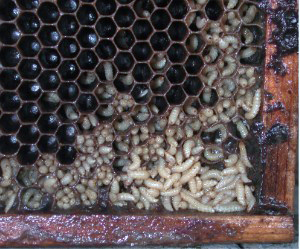 So whilst asking you all to keep an eye open for these colourful hornets and notifying the authorities (or me, if all else fails), the good news from my bees this month is that I have been removing super after super of ivy honey. The fact that there is so much available to remove tells me that the bees have a more than adequate winter reserve of food and pollen (again from ivy but also asters) in their brood chamber and, as last year, do not need any artificial feeding.
So whilst asking you all to keep an eye open for these colourful hornets and notifying the authorities (or me, if all else fails), the good news from my bees this month is that I have been removing super after super of ivy honey. The fact that there is so much available to remove tells me that the bees have a more than adequate winter reserve of food and pollen (again from ivy but also asters) in their brood chamber and, as last year, do not need any artificial feeding.
So all is not doom and gloom, providing we get some longish spells of cold weather. The bees will then stand a very good chance of over-wintering well and coming out strong in the Spring, at which point they will receive another icing-sugar dusting to knock down the Varroa mites in the colony. This is one of the problems with such a prolonged spell of mild weather -Varroa numbers will continue to increase over winter and can overwhelm a winter-diminished colony. But more of that next time.
Colin Rees – 01872 501313 – colinbeeman@aol.com

